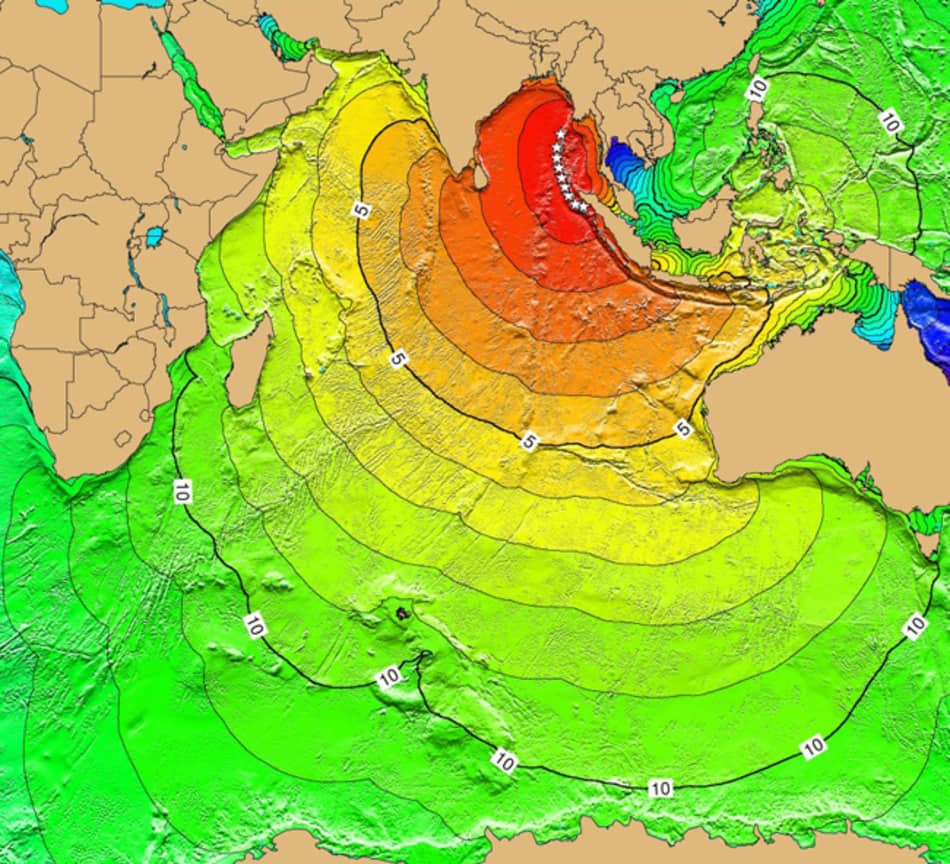
Having 100-foot waves coming at you at high speeds while relaxing on a beach in Thailand is not the ideal getaway. Although extreme tsunamis are rare, understanding the safety measures in place will keep you and your family safe throughout your stay.
Does Thailand have tsunamis? Thailand’s western coastline is open to tsunamis from the Indian Ocean, but it is a rare phenomenon. Prior to the 2004 Indian Ocean earthquake and tsunami, Thailand has no recorded tsunamis. It is near impossible for the Gulf of Thailand to be impacted by a tsunami due to its geographical location.
Other natural disasters are far more common in Thailand than tsunamis, and I’ve covered a list of recent occurrences below. Tsunami warning systems are in place, but I’ll go into more detail on the warning system and how to make sure you receive alerts.
Are Natural Disasters Common in Thailand?
Thailand does not have a history of tsunamis before the 2004 incident. It was brought on due to the massive size of the earthquake, which released the equivalent of 23,000 atomic bombs of energy.
Since 1962, there have been fifteen significant natural disasters in Thailand. Tropical storms are the most common, so it will be crucial to keep an eye on media outlets during your travels to keep up-to-date with the weather patterns. Separate flooding incidents have occurred from indirect tropical storms or due to erratic rainfall during the monsoon season (July-October). Landslides often are categorized similarly with flooding as they go hand in hand, although certain landslides have occurred independently and cause severe casualties.
Most severe natural disasters in Thailand recently recorded:
- 2004 Indian Ocean earthquake and tsunami
- 1962 Tropical Storm Harriet
- 1989 Typhoon Gay
- 2011 Widespread flooding in 65 Provinces
- 2010 Cyclone Jal flooding
- 1997 Tropical Storm Linda
- 2001 Landslide in Phetchabun
- 2006 Flooding in Uttaradit, Sukhothai, Phrae, Lampang, and Nan
- 1997 Flooding triggered by Tropical Storm Zita
- 2006 Flooding caused by Typhoon Xangsane
- 2001 Landslide in Phrae
- 2000 Flooding in Songkhla
- 1990 Tropical Storm Ira
- 1993 Flooding in Nakhon Si Thammarat
- 1988 Landslides in Nakhon Si Thammarat
I’ve gone into more detail about the 10 deadliest natural disasters in Thailand here.
2004 Indian Ocean Earthquake and Tsunami
On December 26, 2004, a massive 9.1 magnitude earthquake sent towering 17.4 meter waves hurling towards Thailand at a speed of 500mph. The tsunami impacted the southern peninsula of Thailand’s western coast. Officially there are over 17,000 casualties in Thailand alone from this incident, a large portion of which were tourists.
Most seriously impacted was the province of Phang Nga, with popular cities such as Khao Lak damaged severely due to an ill-equipped infrastructure of low-rise bungalows, lack of high-rise buildings, flat terrain, and no warning system in place. Grandson to the Thai King was killed in Khao Lak along with thousands of others. Due to the unforeseen nature of this event, warning signs were ignored and compounded death tolls.
As the ocean receded before the waves, many tourists and fishermen followed the receding waters deep into unsafe territory without knowing what was to come.
Following these events, Thailand’s fishing and tourism industry were heavily impacted. Fishermen lost boats, equipment, and most importantly the confidence of the people. Due to religious and health reasons, popular opinion was to avoid eating fish caught from the west coast as those fish may have consumed flesh of the dead dragged out to sea.
Tourism showed an overall decrease of over 25% the following year with a complete lack of tourism in seriously impacted areas due to rebuild. Tsunami warning systems were put in place which has helped rebound and grow the tourism sector.
Government officials were quick to provide relief in the form of aid and grants to help revive businesses and infrastructure. Houses, shopping centers, hotels, cars, boats, roads, power poles, along with personal property were severely damaged.
Thai tourism has had an incredible rebound from this catastrophe and infrastructure has been built to better withstand natural disasters. Patong beach in Phuket for example was almost entirely rebuilt for additional stability against catastrophic weather.
Tourism in Thailand is safer because of the incident, but it is important to know more about the warning signs and be aware of the warning system in place in order to stay safe during your travels.
Tsunami Warning System

As the tsunami raged toward the Andaman coast at over 500 mph, there was a two hour delay between the epicenter and wave impact. Major warning signs included a rapid recession of the sea level exposing reefs and rocks, which were often ignored due to a lack of understanding. As beach dwellers chased out the sea, many were tragically lured to their doom.
Thailand has built the best warning system in Southeast Asia. The National Disaster Warning Centre (NDWC) has built and installed instruments along the Andaman coast over an eight year period. Instruments allow for precise calculation of size and countdown should another earthquake unleash its fury. Within two minutes, instruments will receive messages and send alerts. It’s estimated the entire area will be alerted within a fifteen minute time-frame from the earthquake’s inception.
136 warning towers along with three buoys placed far out in the sea will send data to via satellite to the NDWC staff where data will be collected and interpreted. If an emergency event triggers alerts, staff members will verify with other global authorized monitoring agencies that a disaster has occurred. Upon receiving confirmation, media will be alerted and short messages will be sent to 15,000 public officials. Make sure to keep an eye on out for television or radio alerts during your stay.
NDWC will also have the ability to any monitor seismic activity in the Indian Ocean along with impacts from around the globe. Alerts will be sent when a magnitude of 7.8 or above is detected.
How to Stay Safe
Don’t ignore warning signs. If you receive an alert from the NDWC via media outlets, retreat to high ground immediately. Other warning signs include drastic changes in sea level, either recession or flooding, along with massive waves that may be spotted from a distance. If either of these occur, flee deeper inland and try to locate high rise structures for cover. Resist the temptation to photograph or video tape the incident before retreating to safety.
Related Questions
How often do tsunamis occur in Thailand? Before the 2004 Indian Ocean earthquake and tsunami, there are no recorded tsunamis in recent history in Thailand.
How likely is another tsunami in Thailand? It is very unlikely that Thailand will receive another tsunami and is only at risk on the western coastline. Thailand was impacted by the 2004 tsunami because it was the third largest earthquake ever recorded. Waves traveled over 300 miles to reach Thailand.
How many people died in the Thailand tsunami? 4,812 deaths confirmed, 8,458 injured, 4,499 missing in Thailand.
